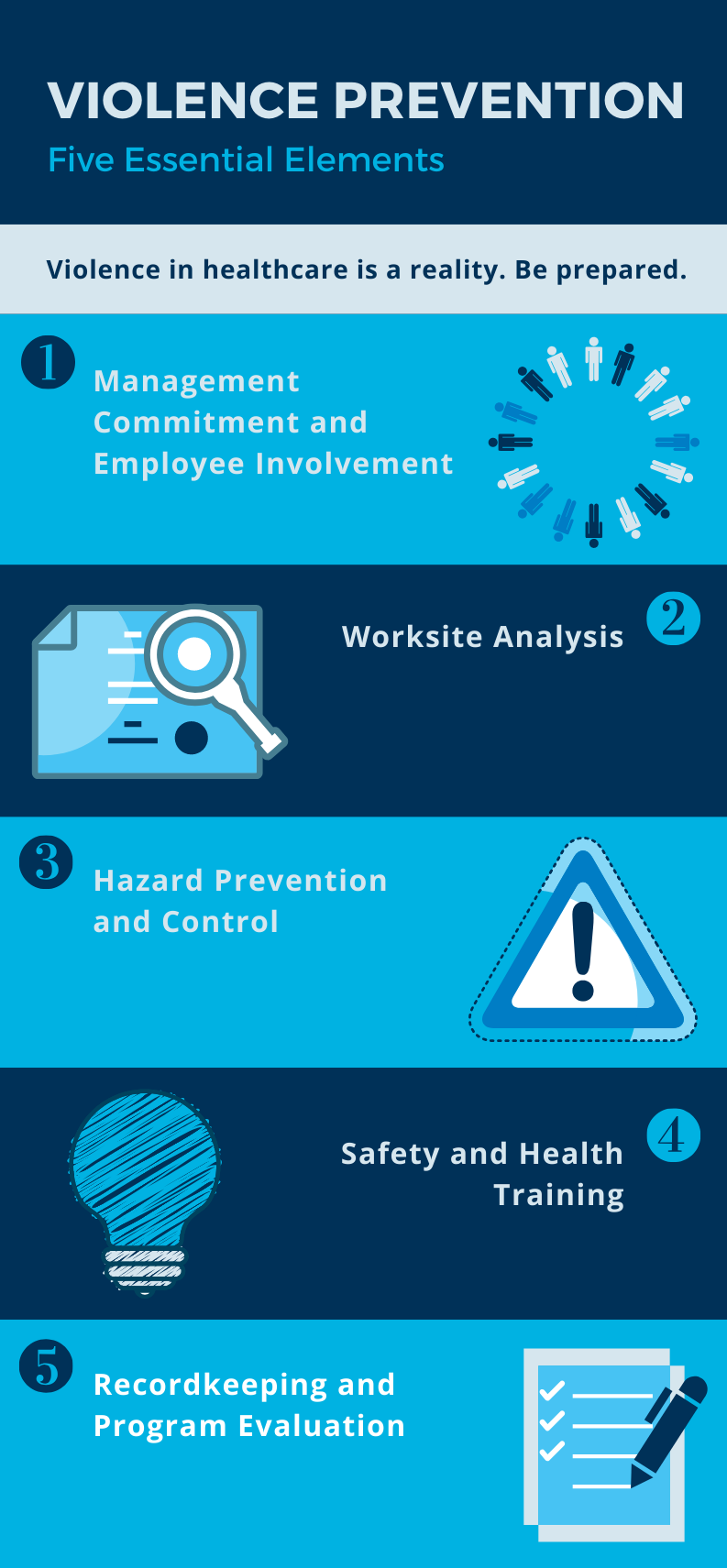Cutting-edge Devices and Resources for California Workplace Violence Prevention Success
Cutting-edge Devices and Resources for California Workplace Violence Prevention Success
Blog Article
The Role of Worker Training and Awareness in Enhancing Workplace Physical Violence Prevention Initiatives Throughout Different Industries
The integration of employee training and understanding right into workplace physical violence prevention efforts is increasingly acknowledged as a basic aspect of organizational safety and security throughout varied industries. By applying targeted training programs, companies can successfully encourage their workforce to determine and address prospective hazards prior to they escalate. However, the efficiency of these campaigns typically hinges on several crucial variables that differ by industry, increasing vital concerns concerning the adaptability of training methods and their real-world impact. Comprehending these nuances may expose techniques that can dramatically enhance safety and security methods and staff member self-confidence in risky atmospheres.
Importance of Educating Programs
In today's dynamic workplace, the value of training programs can not be overstated, particularly in the context of workplace violence avoidance. These programs work as a fundamental aspect in cultivating a secure and safe office culture. By gearing up staff members with the understanding and skills needed to determine, mitigate, and reply to potential hazards, organizations can cultivate an atmosphere that focuses on security and health.
Efficient training programs do greater than merely instruct; they encourage workers to identify warning signs of violence, recognize the protocols for reporting cases, and develop methods to de-escalate potential disputes. They instill a sense of cumulative duty among personnel, motivating proactive participation in maintaining a safe workplace.
Investment in training not only improves staff member understanding yet also shows an organization's commitment to guarding its labor force. This proactive method can result in lowered incidents of workplace violence, lower absenteeism, and enhanced worker spirits. Ultimately, extensive training programs are important to developing a resistant business society that values safety and security and advertises a healthy work environment, thus decreasing the danger of violence and its connected consequences.
Secret Components of Effective Awareness
A comprehensive recognition program incorporates a number of essential parts that are essential for efficiently stopping office physical violence. Initially, clear communication of procedures and plans associated with workplace physical violence is critical. Staff members have to be educated concerning the company's stance on physical violence and the particular methods in position for reporting incidents.
2nd, training sessions must incorporate practical situations that employees may come across. This sensible approach aids workers identify cautioning indicators of potential physical violence and equips them with the needed skills to de-escalate stressful situations. Third, cultivating an encouraging work environment society is vital; workers ought to really feel empowered to speak out without fear of retaliation.
Including feedback devices permits staff members to share their experiences and understandings, which can lead to continual renovation of understanding efforts. By incorporating these parts, companies can produce a robust framework for avoiding workplace physical violence, eventually contributing to a safer and more effective setting for all staff members (california workplace violence prevention).
Industry-Specific Training Techniques
Efficient workplace violence prevention training must be customized to the one-of-a-kind difficulties and risks encountered by details markets. Medical care settings need training that addresses the high chance of encounters with aggressive individuals or visitors. Programs need to concentrate on de-escalation methods, recognizing caution indications of possible violence, and making sure staff understand the value of reporting incidents.
On the other hand, retail settings may face various threats, such as break-in or client disputes. Training in these settings ought to stress situational understanding, feedback procedures throughout emergencies, and the importance of protecting cash money and belongings.
Production and construction markets offer their own dangers, usually related to social conflicts or risky working problems. Training in these sectors must consist of techniques for problem resolution, promoting a culture of safety and security, and encouraging open communication amongst staff members.
Moreover, business workplaces may need training focused on preventing harassment and bullying, fostering a respectful work environment society, and applying clear reporting systems. Each market needs to not just identify its details vulnerabilities but also adapt training products to More Help reverberate with the workforce efficiently, making sure that staff members really feel complete and empowered to handle potential violent situations.
Measuring Training Effectiveness
Evaluating the impact of work environment violence prevention training is important for making sure that workers are effectively prepared to take care of possible my latest blog post threats. To accurately measure training performance, companies must carry out both quantitative and qualitative analysis approaches. Pre- and post-training studies can determine adjustments in worker knowledge, attitudes, and actions worrying workplace physical violence. These studies need to concentrate on particular training objectives to make certain positioning with the organization's objectives.
Additionally, sensible evaluations, such as role-playing circumstances or simulations, can offer understandings into just how well workers use learned abilities in real-life circumstances. Keeping track of case reports prior to and after training can also function as an indicator of performance, as a reduction in cases may mirror improved staff member preparedness.
In addition, comments from individuals need to be methodically gathered to recognize areas for enhancement in training content and distribution. Conducting follow-up analyses at regular intervals aids receive awareness and strengthens training concepts with time - california workplace violence prevention. By employing an extensive strategy to measuring training effectiveness, organizations can make sure that their office physical violence prevention initiatives cultivate a safer atmosphere and improve general worker health
Building a Culture of Safety

Educating plays a crucial role in this cultural shift. Regular, extensive training sessions inform staff members regarding identifying caution indicators of office physical violence and the ideal responses. Furthermore, encouraging open communication enables staff members to voice concerns without fear of retaliation, promoting collective responsibility for safety.
Furthermore, integrating safety right into daily procedures ensures that it becomes a common value instead of a simple conformity concern. This consists of routine security drills, updates on policies, and responses systems that involve employees in safety and security conversations and renovations.
Eventually, a durable society of security not only minimizes the dangers of workplace physical violence however additionally enhances staff member morale and efficiency. By promoting a setting where security is a fundamental top priority, organizations can develop durable workplaces that sustain both individual wellness and collective success.
Conclusion
To conclude, worker training and recognition are crucial components in the see post avoidance of workplace violence throughout various markets. Reliable training programs, tailored to specific market demands, improve staff members' ability to respond and identify to prospective threats. By implementing detailed awareness methods and fostering a society of safety, companies can substantially decrease occurrences of workplace physical violence and boost overall worker morale. Dedication to ongoing training and examination ensures continual performance and adaptability in addressing emerging difficulties within the workplace environment.

Routine, extensive training sessions inform workers regarding acknowledging warning signs of workplace physical violence and the ideal feedbacks.In verdict, worker training and understanding are important elements in the avoidance of work environment violence across numerous sectors.
Report this page